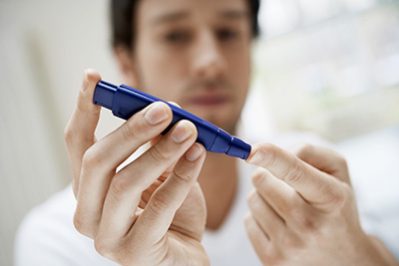Diabetes is a disorder of the body’s system that regulates the amount of sugar in the blood. For our bodies to work properly we need to convert the glucose (sugar) from food we eat, into energy. A hormone called insulin is required to convert the sugar to energy. People with diabetes do not produce enough, or any insulin, to make this conversion happen, and therefore the glucose travels around their body in their blood, and causes the blood sugar level to rise above normal.
There are two types of diabetes:
Type 1 diabetes– occurs in 10 -15% of people with diabetes and is more common in children and young adults. People with Type 1 diabetes do not produce insulin and treatment involves daily injections of insulin, diet control and exercise.
Type 2 diabetes– 80 – 90% of people living with diabetes have Type 2 diabetes It is more common in middle aged or elderly people, and occurs when insulin production occurs, but not at a rate high enough to do what is required. Type 2 diabetes is increasingly occurring in younger people, and is very much a life style related disease. People, who are overweight, do not exercise, have high blood pressure, have poor diets, and carry weight around their stomach are at risk of developing Type 2 diabetes. It can be controlled with diet and exercise, and medication for some.
Diabetics can possibly suffer three reactions:
Hypoglycaemia – the most common complication of diabetes is due to a drop in blood sugar levels and can be caused by:
- not eating enough, missing meals or delaying meals;
- missing or delaying morning or afternoon tea;
- too high a dose of insulin injected;
- unusual strenuous exercise, emotional shock, impact of alcohol;
- change in injection procedure; or
- drinking alcohol.
An insulin reaction may involve the following symptoms: sweatiness, light-headedness, headache and dizziness, lack of concentration, irritability, intense hunger, numbness around lips and fingers.
A diabetic usually knows the warning symptoms and how to avoid a reaction -usually by eating sweet things – sugar, orange juice, soft drinks or chocolate will increase the blood sugar. If there is no improvement in 10- 15 minutes, give more sweet food and seek urgent medical help.
Hyperglycaemia – occurs when the blood sugar level is too high. This can take several days to happen, and can only be confirmed with a finger prick blood test. It can be caused by sickness, infection, too little insulin, and too much carbohydrate food at once, stress.
Symptoms include:
- Excessively thirst;
- Passing high amounts of urine;
- Blurred vision;
- Feeling tired;
- Weight loss;
- Infections.
Ketoacidosis – a serious complication in people with Type 1 diabetes, due to insufficient insulin. This may have been caused by:
- omission of insulin dose or insufficient insulin in dose;
- infections such as flu, gastric upset, not maintaining diet; or
- injury or excessive alcohol.
Ketoacidosis may involve the following symptoms: thirst, flushed cheeks, abdominal pain, deep rapid breathing, vomiting and may result in coma if not treated. It is very important to seek urgent medical treatment.
It is important to find out from parents/caregivers, the symptoms associated with a participant’s diabetes and what treatment is most appropriate.
Programming Considerations
- Some diabetics have to adhere to very strict meal times and this needs to be taken into account when programming activities.
- Important to have constant breaks for fluid and fuel replacement during exercise and eating quality carbohydrates at each break.
- Be aware of triggers and monitor the participants, as they will not be able to explain what they need once are action starts.
Strategies for Inclusion
- Educate all participants about diabetes and tell them what to do if the participant with diabetes has an insulin reaction.
Further information
Diabetes Australia – www.diabetesaustralia.com.au

